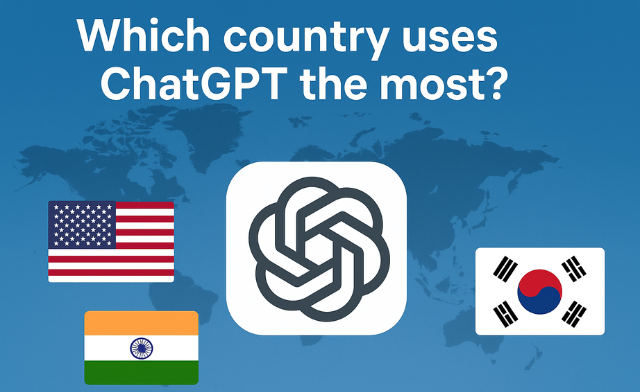Which country uses ChatGPT the most?
Curious which country uses ChatGPT the most? This detailed, original article explains global usage patterns, top countries by traffic and users, why certain nations lead, and what that means for businesses and creators targeting AI-hungry markets.
The question and why it matters
Since its public launch in late 2022, ChatGPT has become a global phenomenon. Marketers, developers, educators, and everyday people use it for writing, coding, research, customer support and more. But usage is not evenly distributed: some countries generate a disproportionately large share of ChatGPT visits and users. If you’re creating content, launching an app, or selling services that use AI, knowing which countries use ChatGPT the most helps you target audiences, choose languages, and plan marketing budgets.
Below we unpack the latest evidence on where ChatGPT is most popular, why those countries lead, and practical takeaways for SEO and business strategy. (All claims below are grounded in recent traffic and usage reports.)
As of the most recent traffic studies and OpenAI usage summaries, the United States remains the single largest source of ChatGPT traffic and paying subscribers overall, but India is close behind (and in some analyses leads in daily adoption). Several middle-income countries (e.g., Brazil, Indonesia, and South Korea) show explosive growth and high engagement. The exact ranking depends on whether you measure total visits, share of global traffic, daily active users, or paid subscribers.
How researchers measure “which country uses ChatGPT the most”
Before diving into rankings, it helps to understand measurement methods — different metrics can change the answer.
-
Site traffic share (visits to chat.openai.com / chatgpt.com): Common web-analytics firms estimate the percentage of global ChatGPT visits that originate from each country. This is useful for gauging absolute demand.
-
Monthly active users / weekly active users: Data reported by OpenAI or aggregated by research firms shows how many people actively used ChatGPT within a time window. Useful for engagement.
-
Daily use / frequency: Surveys and panels report how often people use ChatGPT in each country (daily, weekly, rarely). This reveals stickiness and habitual use.
-
Paid subscribers: The count of paying users by country reflects commercial adoption and willingness to pay for premium features. South Korea, for example, ranks very highly in paid subscribers outside the U.S. in recent reports.
Because each metric highlights a different angle, the “winner” changes if you ask “most visits” versus “most daily users” versus “most paying subscribers.”
Who’s at the top right now (breakdown)
United States — steady leader in overall traffic and paying users
The U.S. often ranks first in global share of ChatGPT visits and in the number of paying subscribers. As the home market for OpenAI and with a large English-speaking internet population, the U.S. produces a large absolute volume of traffic and early commercial adoption. Many enterprise and developer integrations also originate in the U.S., amplifying usage.
India — massive growth and huge daily usage
India’s internet population is enormous and rapidly adopts new consumer tech. Several recent traffic analyses show India either matching or surpassing the U.S. on some measures (notably daily active users and shares of visits in certain months). India’s combination of a young, digital-native population, high smartphone penetration, and demand for productivity and learning tools drives heavy ChatGPT engagement.
Brazil, Indonesia and other emerging markets — fast expansion
Latin America and Southeast Asia display impressive growth rates. Brazil often appears in the top five for share of ChatGPT traffic, and Indonesia has shown some of the fastest year-on-year increases. These markets demonstrate that ChatGPT adoption is not only a high-income country phenomenon — lower- and middle-income countries are adopting at scale.
South Korea — high-paying subscriber penetration
South Korea stands out for paid subscriber density and engagement. OpenAI’s own strategic moves, including opening an office and partnering locally, reflect South Korea’s importance as a market for both consumer and enterprise AI. Reports indicated rapid growth in weekly users and high numbers of paying customers relative to population.
Why certain countries lead — five core factors
-
Language and English fluency. ChatGPT initially performed best in English; countries with large English-speaking populations (U.S., India, UK, Canada) saw immediate adoption. Over time multilingual improvements expanded reach, but early leads persisted.
-
Device and broadband penetration. Nations with wide smartphone and broadband access produce more traffic. As connectivity improves, adoption surges in previously lower-usage countries.
-
Local partnerships and product availability. OpenAI’s local partnerships, localized products, and even offices (e.g., Seoul) accelerate uptake and paid subscriptions in target countries.
-
Education and workforce needs. Students, developers, small businesses and freelancers in high-growth economies use ChatGPT for learning, coding help, content production, and customer support — practical use cases that sustain daily engagement.
-
Affordability & pricing models. When paid tiers are priced accessibly or when free tiers remain robust, adoption rises faster in price-sensitive markets. Bundles, local payment options, and partnerships impact conversion to paying users.
Caveats & limitations — why rankings change
-
Different data sources, different rankings. Web traffic firms, OpenAI’s internal metrics, and third-party surveys measure different things; rankings shift depending on the metric you choose (visits vs. active users vs. paid subscriptions). Always state which metric you’re using.
-
Rapid change. Adoption curves for AI tools are steep — a country’s position can shift quickly after product launches, pricing changes, partnerships, or local regulation. Use the latest reports when planning campaigns.
-
API vs consumer site traffic. Many businesses use the ChatGPT API rather than the consumer site; API usage by country is harder to attribute to end users and can skew the picture if you only look at chat.openai.com traffic.
Practical checklist: targeting top ChatGPT markets (quick action items)
-
Research keyword intent for “how to use ChatGPT” + local language terms in your target country.
-
Publish local-language guides (e.g., “ChatGPT for students in India”) with examples tailored to local syllabuses and job markets.
-
Optimize pages for mobile speed and include short video demos (many users prefer quick visual walkthroughs).
-
Offer region-specific pricing or trials if you sell AI tools — align with local payment methods.
-
Track performance by country in analytics and iterate content and promos based on engagement metrics.
The nuanced reality
There isn’t a single definitive answer because the “most” depends on what you measure. On overall traffic and paying subscribers, the United States often leads; on daily active usage and dramatic growth, India and several emerging markets are rapidly closing the gap. South Korea is notable for high paid-subscriber density. For anyone creating AI-adjacent content or services, the opportunity is global — but the most lucrative or highest-engagement markets can vary by metric, language and price sensitivity. Use up-to-date traffic and OpenAI reports when planning, and localize both content and monetization strategies for the biggest impact.

